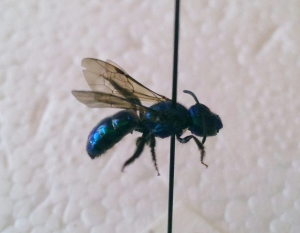Augochlora buscki Cockerell
FEMALE (genus) (From The Bees of the World – Michener 2007)
- proboscis not so slender, prementum 4 to 8 times as long as broad; proboscidial fossa much wider than mandibular base
- inner hind tibial spur serrate, teeth shorter than wide, pointed or rounded, or margin of spur undulate or ciliate
- scopa and median slit or notch and area of fine hairs on T5 present; integument rarely so coarsely punctate
- labral process with strong median keel, usually pointed
- inner hind tibial spur with rounded serrations, preoccipital ridge sharply angled or carinate
- epistomal suture forming acute paraocular lobe protruding into clypeus
- clypeus relatively flat, green almost to apex
- anterior angle of hypostomal carina usually a sharp right angle or produced into spine
- apex of marginal cell narrowly truncate and usually appendiculate (not quite all the way touching the wing margin)
SPECIES (Female) (from: Some bees of the genus Augochlora from the west indies by TDA Cockerell, Proceedings of the national museum, volume 37, p.493)
- Length about 10 mm.;
- head and thorax brilliant bluegreen;
- abdomen yellowish-green, with purple tints laterally,
- the hind margins of the segments being very broadly black, the black largely suffused with purple ;
- head and thorax very densely and quite strongly pitted,
- the pits of the mesothorax separately visible under a lens;
- pubescence scanty, and poorly preserved in the specimen, but evidently short and black or mainly so on face and head and thorax above,
- pallid on ventral surface;
- head ordinary, not elongate, cheeks broad, and with a, small but evident tubercle beneath;
- eyes deeply emarginate;
- clypeus shining, with scattered punctures, its disk purple-tinted, but its upper margin narrowly golden-green;
- mandibles black, with a blue spot at base;
- antennnae dark;
- scutellum closely and minutely punctured,
- higihbous, with a ‘median sulcus; area of metathorax with numerous strong longitudinal strikes, which curve outwards a little just before reaching its outer edge;
- posterior face of metathorax dulish, without any sharp rim;
- tegula piceous with a rufous spot, the anterior base metallic;
- wings very dark reddish; stigma and nervures dark red-brown;
- first recurrent nervure joining second transverso-cubital, but toward outer side ;
- legs brown-black, anterior femora blue-green behind;
- hind spur microscopically serrate, the teeth dark;
- abdomen only moderately shining;
- venter with long hair, partly black and partly dull white.
- The claw-joints are ferruginous.





